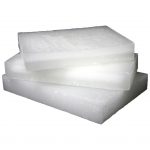Coating
Petroleum jelly can be used to coat corrosion-prone items such as metallic trinkets, non-stainless steel blades, and gun barrels prior to storage as it serves as an excellent and inexpensive water repellent. It is used as an environmentally friendly underwater antifouling coating for motor boats and sailing yachts. It was recommended in the Porsche owner’s manual as a preservative for light alloy anodized Fuchs wheels to protect them against corrosion from road salts and brake dust. “Every three months (after regular cleaning) the wheels should be coated with petroleum jelly.
Finishing
It can be used to finish and protect wood, much like a mineral oil finish. It is used to condition and protect smooth leather products like bicycle saddles, boots, motorcycle clothing, and used to put a shine on patent leather shoes (when applied in a thin coat and then gently buffed off).
Lubrication
Petroleum jelly can be used to lubricate zippers and slide rules. It was also recommended by Porsche in maintenance training documentation for lubrication (after cleaning) of “Weather-strips on Doors, Hood, Tailgate, and Sun Roof”. The publication states “…before applying a new coat of lubricant…” “Only acid-free lubricants may be used, for example: glycerin, Vaseline, tire mounting paste, etc. These lubricants should be rubbed in, and excessive lubricant wiped off with a soft cloth.” It is used in bullet lubricant compounds.
Industrial production processes
Petroleum jelly is a useful material when incorporated into candle wax formulas. The petroleum jelly softens the overall blend, allows the candle to incorporate additional fragrance oil, and facilitates adhesion to the sidewall of the glass. Petroleum jelly is used to moisten nondrying modelling clay such as plasticize, as part of a mix of hydrocarbons including those with greater (paraffin wax) and lesser (mineral oil) molecular weights. It is used as a tack reducer additive to printing inks to reduce paper lint “picking” from uncalendared paper stocks. It can be used as a release agent for plaster molds and castings. It is used in the leather industry as a waterproofing cream.
Explosives
Petroleum jelly is mixed with a high proportion of strong inorganic chlorates due to it acting as a plasticizer and a fuel source. An example of this is Cheddite C which consists of a ratio of 9:1, KClO3 to petroleum jelly. This mixture is unable to detonate without the use of a blasting cap. It is also used as a stabilizer in the manufacture of the propellant Cordite.
Mechanical, barrier functions
Petroleum jelly can be used to coat the inner walls of terrariums to prevent animals crawling out and escaping.
A stripe of petroleum jelly can be used to prevent the spread of a liquid. For example, it can be applied close to the hairline when using a home hair dye kit to prevent the hair dye from irritating or staining the skin. It is also used to prevent diaper rash.
Surface cleansing
Petroleum jelly is used to gently clean a variety of surfaces, ranging from makeup removal from faces to tar stain removal from leather
Clean-up
Petroleum jelly is very sticky and hard to remove from non-biological surfaces with the usual and customary cleaning agents typically found in the home. It may be dissolved with paint thinner or other petroleum solvents such as acetone, which dissolves many plastics.
Petroleum jelly is slightly soluble in alcohol. To avoid damage to plastics and minimize ventilation issues, isopropyl (rubbing) alcohol can be used to remove petroleum jelly from most surfaces. Isopropyl alcohol is inert to most household surfaces, including almost every plastic, and removes petroleum jelly efficiently. While alcohol causes fewer ventilation problems than petroleum solvents, ventilation is still recommended, especially if large surface areas are involved.
Petroleum jelly is also soluble in lower-molecular-weight oils. Using an oil to dissolve the petroleum jelly first can render it more soluble to solvents and soaps that would not dissolve pure petroleum jelly. Vegetable oils such as canola and olive oil are commonly used to aid in the removal of petroleum jelly from hair and skin
Physical properties
Petroleum jelly is a mixture of hydrocarbons, with a melting point that depends on the exact proportions. The melting point is typically between 40 C and 70 C. It is flammable only when heated to liquid; then the fumes will light, not the liquid itself, so a wick material like leaves, bark, or small twigs is needed to ignite petroleum jelly. It is colorless or has a pale yellow color (when not highly distilled), translucent, and devoid of taste and smell when pure. It does not oxidize on exposure to the air and is not readily acted on by chemical reagents. It is insoluble in water. It is soluble in dichloromethane, chloroform, benzene, diethyl ether, carbon disulfide and oil of turpentine.
Depending on the specific application of petroleum jelly, it may be USP, B.P., or Ph. Eur. grade. This pertains to the processing and handling of the petroleum jelly so it is suitable for medicinal and personal-care applications.




